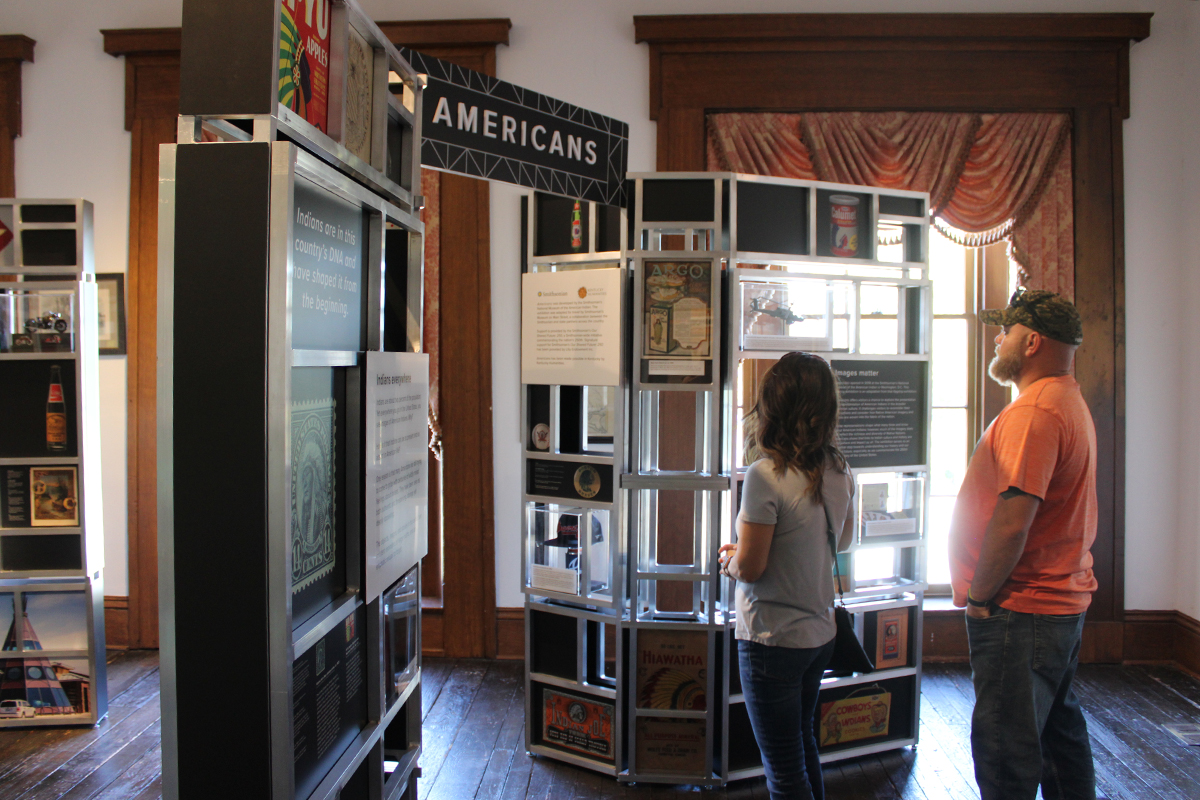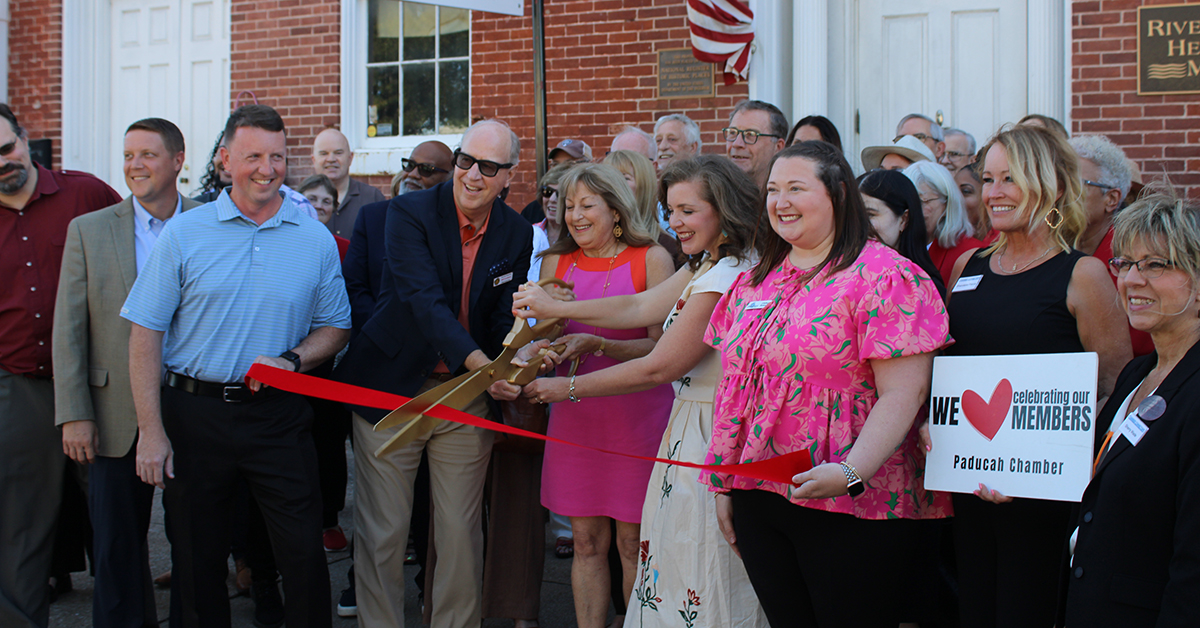The River Discovery Center in Paducah, Ky., is the first museum in the state to host a traveling exhibit based on a major exhibition at the Smithsonian’s National Museum of the American Indian in Washington, D.C.
“Americans” explores what it calls the “deeply entangled history that Americans and American Indians share.” The Kentucky Humanities Council notes that, while American Indians make up less than 1 percent of the population, images of them are everywhere, from commercial products to professional and high school sports mascots, classic TV Westerns, state, city and street names, and even the Tomahawk missile. The exhibit highlights four major historical events, presenting “what has been remembered, contested, cherished and denied” about American Indians while also showing why each event still resonates.
The exhibit is part of the Smithsonian’s Museum on Main Street program and was created with support from state humanities councils and other state partners, Kentucky Humanities Council Executive Director Bill Goodman said. It opened August 26 at the River Discovery Center and is traveling to museums in rural areas of Kentucky through July 5, 2026. A second version of the exhibit is currently traveling in Kansas.
“The Smithsonian feels that it is important to talk about history and facts and figures throughout our entire existence as the United States of America,” Goodman said. “This particular exhibit is about the peoples who were here before anyone else, about the Native Americans who inhabited parts of these United States, the Eastern part of the United States, as well as much of Kentucky.”
The Smithsonian carefully verified the information in the exhibit to ensure accuracy, Goodman said. Visitors may be interested in learning the true story of Pocahontas, he said, or about the Trail of Tears, both of which are explored in depth.
“Americans” is visiting Paducah—the only Kentucky city named after an Indian tribe, the “Padouca”—through September 27. Paducah was also a stop on a portion of the waterways route of the Trail of Tears, as commemorated on a plaque at the riverfront.
“Our name reflects Native history, and our location on the river shaped the industries and communities that grew here,” River Discovery Center Executive Director Lindsey Launius said. “Visitors can experience the exhibit’s national themes and then see how they connect with the local history and river stories we highlight at the museum.”
The “Americans” exhibit is a good fit for the River Discovery Center for multiple reasons, Launius said.
“The ‘Americans’ exhibit explores how imagery and stories have shaped our national identity,” she said. “The River Discovery Center is all about connecting people to history, culture and the forces that have shaped communities along the river. Both encourage us to reflect on where we’ve been and how those stories continue to influence our lives today. Hosting an exhibit of this caliber also allows us to welcome new audiences into the museum, broadening our visibility and giving us the opportunity to share the rest of our museum experience with people who may be visiting for the first time.”
The exhibit is open during the center’s regular hours of 9:30 a.m. to 5 p.m. Monday through Saturday and 1 to 5 p.m. on Sundays. Admission to the exhibit is free, thanks to support from the Smithsonian Institution and the Kentucky Humanities Council. Admission to the rest of the River Discovery Center is separately priced at $8 for adults, $7 for seniors 65 and older, $5 for students from kindergarten through college and free for children under 5. Visitors are welcome to explore just the Smithsonian exhibit or to purchase museum admission while visiting.
The “Americans” exhibit is the third Smithsonian exhibit the River Discovery Center has hosted.

“Smithsonian exhibits bring nationally recognized scholarship and storytelling to Paducah,” Launius said. “They broaden what we can offer our community while still tying back to our mission. They also help us reach new visitors, which strengthens the River Discovery Center’s role as both an educational resource and a tourism destination.
That visibility matters, she said.
“Every new visitor is a chance to spark curiosity about the river industry, highlight STEM and river-related careers and support recruitment for the next generation of the river workforce,” Launius said.
The response to the exhibit is bigger than the two previous ones, with schools scheduling field trips nearly every day in September with up to 120 students at a time, she said.
“That kind of engagement shows how exhibits like this help us inspire the next generation and broaden awareness of the opportunities the river industry provides,” Launius said.
Launius said she is excited to see young people connect with the exhibit and the museum and for both to inspire curiosity about history, culture and the river industry. She hopes families and educators also will get a taste for what the museum has to offer year-round.
Additionally, she said, it’s a chance to experience a Smithsonian-caliber exhibit without having to travel.
“It’s a rare opportunity for students, families and visitors to connect national stories with local history,” she said. “It’s also an open door for people who may not have visited us before. Once they’re here for ‘Americans,’ they’ll discover the full River Discovery Center and the stories of the river that continue to shape our community today.”
Featured image caption: Bill Goodman, executive director of the Kentucky Humanities Council, Julie Harris, outgoing director of the River Discovery Center, and Lindsey Launius, incoming director, cut the ribbon August 26 to open “Americans,” a traveling Smithsonian Institution exhibit visiting the Paducah museum. They are surrounded by museum staff and members of the Paducah Area Chamber of Commerce. (Photo by Shelley Byrne)



